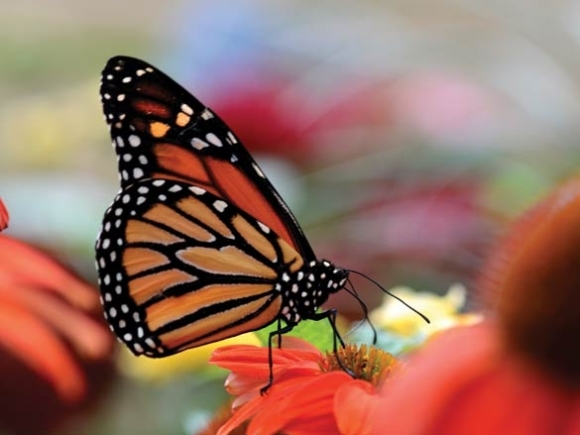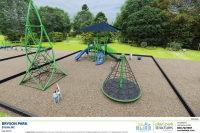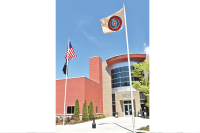Winged wonders: Butterfly house is a living exhibit at the N.C. Arboretum

It’s one of those summer days that’s so hot and humid it’s impossible to walk even two steps without sweating, and inside the butterfly house the air is even heavier, thick as a tropical rainforest.
But, for the butterflies, it’s perfect.
“They’re happy,” explains Mary Harrill, curator of the temporary Winged Wonders exhibit at the N.C. Arboretum in Asheville. “They’re reproducing. They’re mating, laying eggs.”
Stepping into the greenhouse is like stepping into a slowed-down version of time. Butterflies drift placidly from flower to flower, unfurling their proboscises — the long, straw-like protrusions that they use to eat — when they find some especially tasty nectar. Some of them sit perched, methodically opening and closing their wings to gather heat from the air, while others cling to the warm, translucent greenhouse walls.
 In a locked wooden box, rows of butterflies-to-be hang from dowel rods. Called chrysalises, these little packages are in transition from caterpillarhood to emergence as butterflies. Their appearance varies greatly, depending on the species — they range from the brown, knobby structures containing gulf fritillary pupae to the creamy green chrysalis of the monarch butterfly, jewel-like with its diamond shape and line of gold studs across the center.
In a locked wooden box, rows of butterflies-to-be hang from dowel rods. Called chrysalises, these little packages are in transition from caterpillarhood to emergence as butterflies. Their appearance varies greatly, depending on the species — they range from the brown, knobby structures containing gulf fritillary pupae to the creamy green chrysalis of the monarch butterfly, jewel-like with its diamond shape and line of gold studs across the center.
Visitors mill in and out — adults often accompanied by cameras, children, or both.
Related Items
Lorraine and Michael Lanius, with their 3- and 5-year-old grandsons in tow, are among them, Lorraine explaining to the boys how the butterflies emerge from the chrysalises now hanging in the box, and how when winter comes the monarchs fly all the way south to Mexico.
“We just like to get them out of the house from time to time,” Lorraine laughs when asked why they made the trip.
The Lanius’s have plenty of butterfly-attracting plants in their own yard, but the experience at the arboretum is different. Here, the butterfly garden is enclosed, all stages of the life cycle existing together. Butterflies flit through the air, chrysalises wait to hatch, and eggs and caterpillars cling to the plants. And it’s all right there, at close range.
“When butterflies are out in the wild, they’re more skittish and you really don’t get to see them up close and personal like this,” Harrill said. “You don’t get to actually have a butterfly feeding right in front of you because they usually fly away when you get close to them.”
These butterflies aren’t skittish. In fact, some of them will use visitors’ shirts as landing pads.
Actually holding the butterflies isn’t allowed. They’re fragile, so even a slight mishandling can cause serious damage. But when volunteers are available to hand them out, the exhibit includes butterfly wands — sticks that have nectar sponges on the end where butterflies will sit and eat.
“You can hold that as close to your face as you want and see how the butterflies taste with their feet,” Harrill said. “They taste that it’s sweet, and then they unroll their proboscises and start sucking out of the wand.”
Currently, the butterfly house contains four species native to the area — monarchs, eastern tiger swallowtails, gulf fritillaries and painted ladies. The arboretum receives 100-150 chrysalises every week from its supplier in Florida, which then hang in the chrysalis box to hatch over the course of the next seven days. Most of the butterflies live for about two weeks after they hatch as adults.
Sharing the exhibit with arboretum visitors has been a thrilling experience, Harrill said, because many of them arrive with little understanding of how the butterfly life cycle actually works. When they leave, they’ve been able to change that by passing within arm’s length of the whole thing.
“They’re able to appreciate that a butterfly isn’t just a pretty thing that’s flapping about,” Harrill said. “A butterfly is something that’s actually beneficial. The adults help pollinate plants. The caterpillars help trim plants down — they’re nature’s pruners. And then they’re part of the food chain too, on top of it.”
 The Winged Wonders exhibit is the first butterfly exhibit the arboretum has hosted since 2008. About six months of planning preceded its opening to the public, with funds coming from money the N.C. Arboretum Society has raised through events such as Winter Lights.
The Winged Wonders exhibit is the first butterfly exhibit the arboretum has hosted since 2008. About six months of planning preceded its opening to the public, with funds coming from money the N.C. Arboretum Society has raised through events such as Winter Lights.
However, the exhibit is just one part of the arboretum’s overall focus on pollinator species in recent years.
In 2016, the N.C. Arboretum became one of seven Bee Campus USA gardens nationwide, marking it as an educational campus that’s committed to practices supporting pollinators such as bees and butterflies. As part of the certification, the arboretum focused its 2016 seasonal exhibits on plants and nesting sites for pollinator species, also working with volunteers and outside organizations to create pollinator gardens in the community.
Many types of butterflies and bees have seen declining numbers in recent decades, with a variety of factors to blame. Pesticides on the plants they eat can reduce their chances of survival, and increased development can make good habitat hard to come by. Monocrop agriculture can also hurt populations by cutting down on the diversity of species these insects need to thrive.
In 2015, the arboretum instituted what is now an annual Monarch Butterfly Day event held in September, and in 2017 butterflies will get the focus all year long.
The Winged Wonders exhibit, which opened May 13, will operate through Oct. 29, and several new butterfly-focused plantings now adorn the Forest Meadow, in addition to interpretive signage about butterflies and other pollinators. The arboretum’s signature Quilt Garden features a butterfly quilt block pattern, and Waynesville artist Grace Cathey has designed an upright kaleidoscope sculpture called “Life of the Monarch” to illustrate the different stages of a monarch’s life cycle — the sculpture is located at the arboretum’s Forest Meadow.









